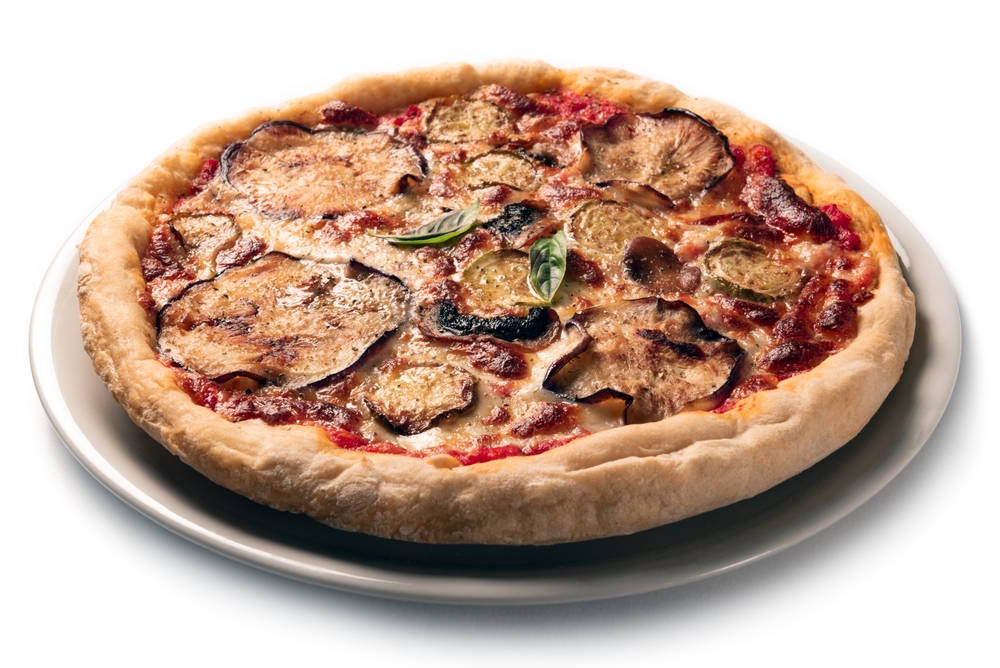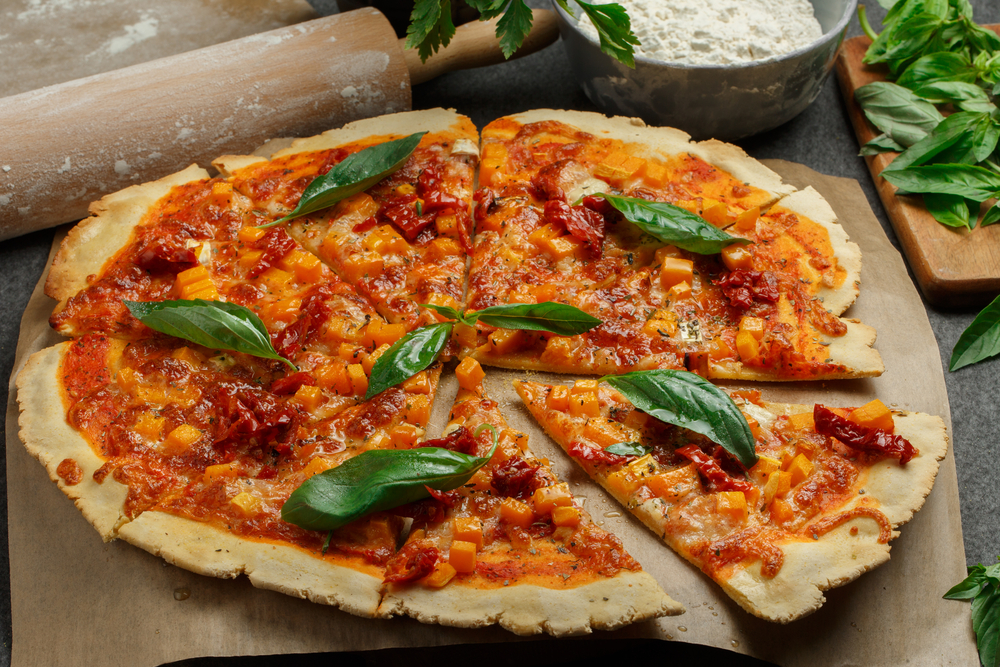One query that frequently arises in relation to pizza is whether or not it includes gluten. For people with gluten sensitivity, celiac disease, or wheat allergies, the protein gluten, which is present in wheat, barley, and rye, might be problematic.

If you’re looking for gluten-free food options, it’s critical to know if pizza fits into your diet.
Pizza’s crust determines whether it includes gluten or not. Since wheat flour is used to make traditional pizza crust, it does include gluten.
However, a variety of gluten-free pizza crusts derived from components like cauliflower, zucchini, rice flour, or almond flour are now widely accessible.
Before ordering or creating your own pizza, it’s crucial to check the crust’s ingredients to be sure it is gluten-free.
It’s also crucial to be watchful and read labels before consuming because toppings like pizza sauce, cheese, and processed meats may also contain gluten.
Due to the fact that pizza is frequently made in the same kitchen as gluten-containing meals, cross-contamination can also be a problem.What is Gluten?
Gluten is a type of protein found in wheat, barley, and rye. It is what gives dough its elasticity, allowing it to rise and hold its shape. Gluten is also commonly found in many processed foods, such as bread, pasta, and baked goods.
For those with celiac disease or a gluten intolerance, consuming gluten can cause a range of symptoms, including bloating, abdominal pain, and diarrhea. In severe cases, it can lead to damage to the small intestine and malabsorption of nutrients.
Wheat is the most common source of gluten, and it is found in a variety of forms, including wheat flour, wheat bran, and wheat germ. Barley and rye also contain gluten, although in lower amounts than wheat.
It’s important to note that not all grains contain gluten. Some gluten-free alternatives include rice, quinoa, and corn. However, it’s important to always check food labels to ensure that a product is truly gluten-free.
In summary, gluten is a protein found in wheat, barley, and rye that can cause issues for those with celiac disease or a gluten intolerance. It’s important to be aware of which foods contain gluten and to seek out gluten-free alternatives when necessary.
What is Gluten Sensitivity?
Gluten sensitivity is a condition that affects a significant number of people worldwide. It is a condition that occurs when the body is unable to tolerate gluten, a protein found in wheat, barley, and rye.

Gluten sensitivity is not the same as celiac disease or wheat allergy, although the symptoms may be similar.
Celiac disease is an autoimmune disorder that causes damage to the small intestine when gluten is consumed.
It affects about 1% of the population and can be diagnosed through a blood test or biopsy. Wheat allergy, on the other hand, is an allergic reaction to wheat, which can cause symptoms such as hives, itching, and difficulty breathing.
Non-celiac gluten sensitivity is a condition where individuals experience symptoms similar to those of celiac disease, but without the same damage to the small intestine.
The symptoms can include bloating, abdominal pain, diarrhea, constipation, headaches, and fatigue.
It is important to note that gluten sensitivity is not a fad or a trend. It is a real condition that affects many people, and it is essential to take it seriously.
If you suspect that you have a gluten sensitivity, it is important to consult with a healthcare professional to determine the best course of action.
In summary, gluten sensitivity is a condition that occurs when the body is unable to tolerate gluten. It is not the same as celiac disease or wheat allergy, although the symptoms may be similar.
Non-celiac gluten sensitivity is a condition where individuals experience symptoms similar to those of celiac disease, but without the same damage to the small intestine.
If you suspect that you have a gluten sensitivity, it is important to consult with a healthcare professional to determine the best course of action.
Pizza Dough Ingredients
When it comes to pizza dough, the ingredients used can make all the difference. Here, we’ll take a closer look at the main ingredients used in pizza dough, including wheat flour and gluten, gluten-free options, and other ingredients commonly used.

Wheat Flour and Gluten
Traditionally, pizza dough is made using wheat flour, which contains gluten. Gluten is a protein that gives dough its elasticity, allowing it to rise and become fluffy when baked.
However, for those with gluten sensitivities or celiac disease, wheat flour and gluten can cause digestive issues and discomfort.
For those who can tolerate gluten, wheat flour is a common and affordable option for making pizza dough. However, for those who need to avoid gluten, there are now many gluten-free options available.
Gluten-Free Options
Gluten-free pizza dough can be made using a variety of alternative flours, such as corn, rice, or almond flour.
These flours do not contain gluten, but they may require additional ingredients or preparation methods to achieve the desired texture and flavor.
Many stores now offer pre-made gluten-free pizza crusts, which can be a convenient option for those with gluten sensitivities.
It’s important to note that while these crusts may be gluten-free, they may still be prepared in a kitchen that also handles gluten-containing ingredients, which could lead to cross-contamination.
Other Ingredients
In addition to flour and gluten, pizza dough typically includes other ingredients such as yeast, salt, sugar, and oil.
Yeast is used to help the dough rise, while salt and sugar are added for flavor. Oil is often added to the dough to help keep it from sticking to the pan or stone during baking.
The ingredients used in pizza dough can vary depending on personal preference and dietary restrictions.
Whether you opt for traditional wheat flour dough or a gluten-free alternative, there are many options available to suit your needs.
Pizza Toppings and Gluten
When it comes to pizza, the toppings can make or break the experience. But for those with gluten sensitivities or celiac disease, the question of whether or not pizza toppings contain gluten is a crucial one. Here, we’ll explore the different types of pizza toppings and whether or not they contain gluten.

Gluten-Free Toppings
Fortunately, there are plenty of toppings that are naturally gluten-free. These include:
- Vegetables such as onions, peppers, mushrooms, and olives
- Meats such as chicken, ham, and bacon
- Cheeses such as mozzarella, cheddar, and feta
- Sauces such as tomato sauce and pesto (as long as they don’t contain wheat flour)
If you’re looking for a gluten-free pizza, it’s important to make sure that any toppings you choose are also gluten-free.
Some pizzerias may offer gluten-free crusts but use toppings that contain gluten, which can lead to cross-contamination.
Cross-Contamination
Cross-contamination is a concern when it comes to gluten-free pizza. Even if the toppings themselves are gluten-free, they can become contaminated if they come into contact with gluten-containing surfaces or ingredients. This can happen in a number of ways, including:
- Shared equipment: If the pizzeria uses the same equipment to prepare both gluten-free and regular pizzas, there is a risk of cross-contamination.
- Handling: If the person preparing the pizza touches gluten-containing ingredients and then touches the gluten-free toppings, cross-contamination can occur.
- Ingredients: Sometimes, seemingly gluten-free ingredients can contain trace amounts of gluten due to cross-contamination during processing.
To minimize the risk of cross-contamination, it’s important to choose a pizzeria that takes gluten-free preparation seriously.
Look for a pizzeria that offers a separate preparation area and uses separate equipment for gluten-free pizzas. Additionally, make sure to communicate your gluten-free needs clearly to the staff.
There are plenty of gluten-free pizza toppings to choose from, but it’s important to be aware of the risk of cross-contamination.
By choosing a pizzeria that takes gluten-free preparation seriously and being vigilant about cross-contamination, you can enjoy a delicious and safe gluten-free pizza experience.
Making Homemade Gluten-Free Pizza
When it comes to making homemade pizza, going gluten-free doesn’t mean sacrificing taste or texture.

With the right ingredients and techniques, we can create a delicious gluten-free pizza that rivals its wheat-based counterpart.
Gluten-Free Flour Options
The key to a successful gluten-free pizza crust is finding the right flour. While wheat flour provides the elasticity and structure necessary for traditional pizza dough, we can achieve similar results with alternative flours. Some popular gluten-free flour options for pizza crust include:
- Rice flour: This mild-flavored flour is a common choice for gluten-free baking. It’s versatile and easy to work with, but can result in a slightly grainy texture.
- Almond flour: Made from ground almonds, this flour adds a nutty flavor and crispy texture to pizza crusts. It can be a bit denser than other flours, so it’s often used in combination with other gluten-free flours.
- Chickpea flour: Also known as garbanzo bean flour, this high-protein flour adds a savory flavor and chewy texture to pizza crusts. It’s best used in combination with other gluten-free flours to balance out its strong taste.
Tips for a Great Texture
Achieving the right texture is key to making a delicious gluten-free pizza. Here are some tips to help us get it just right:
- Use a combination of gluten-free flours: No single gluten-free flour can perfectly mimic the texture of wheat flour, so using a blend of flours can help achieve a more balanced texture.
- Add xanthan gum: This common gluten-free baking ingredient helps bind the dough together and improve its elasticity. It’s often used in combination with other gluten-free flours.
- Let the dough rest: Allowing the dough to rest for at least 30 minutes before shaping and baking can help improve its texture and flavor.
Gluten-Free Pizza Recipes
Ready to try making your own gluten-free pizza at home? Here are a few recipes to get us started:
- Gluten-Free Pizza Crust by King Arthur Baking: This recipe uses a blend of rice flour, tapioca starch, and potato starch to create a crispy and chewy crust.
- Almond Flour Pizza Crust by The Spruce Eats: Made entirely from almond flour, this crust is crispy and flavorful.
- Chickpea Flour Pizza Crust by Minimalist Baker: This high-protein crust is made from a blend of chickpea flour, tapioca starch, and almond flour for a chewy texture and nutty flavor.
With these tips and recipes, we can confidently make our own delicious gluten-free pizza at home.
Conclusion
Pizza can contain gluten depending on the type of crust and toppings used. It is important to check the ingredients and ask about potential cross-contamination when ordering pizza.
For those with gluten sensitivities or celiac disease, gluten-free crust options are available at many pizzerias. These crusts are typically made with alternative flours such as rice flour, almond flour, or tapioca flour.
When it comes to toppings, there are many options that are both delicious and gluten-free. Vegetarian toppings such as mushrooms, onions, peppers, and olives are all safe choices.
Additionally, healthy fats such as avocado and grilled chicken can be added to a pizza for added nutrition.
It is important to note that some individuals may experience hives or other allergic reactions to certain pizza toppings. It is always best to consult with a doctor if you have any concerns about food allergies.
Pizza can be enjoyed as part of a balanced diet, but it is important to be mindful of the ingredients and potential allergens. With the right choices, pizza can be a delicious and satisfying meal for everyone to enjoy.







Add comment